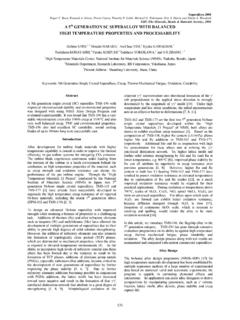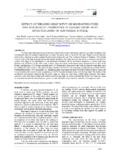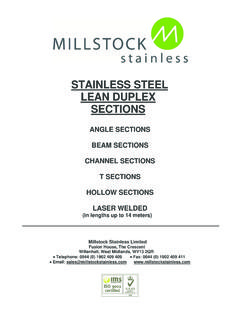Transcription of Microstructure and Mechanical Properties of Two Api Steels ...
1 Materials Research. Microstructure and Mechanical Properties of Two Api Steels for Iron Ore PipelinesLeonardo Barbosa Godefroid*, Luiz Cl udio C ndido, Rodrigo Vicente Bay o Toffolo, Luiz Henrique Soares BarbosaRede Tem tica em Engenharia de Materiais REDEMAT, Universidade Federal de Ouro Preto UFOP, CEP 35400-000, Ouro Preto, MG, BrasilReceived: June 26, 2013; Revised: March 17, 2014 This research compares the Mechanical behavior of two API Steels (X60 and X70) used in the longest pipeline in the world for the conveyance of iron ore.
2 Tensile tests, Charpy impact tests, CTOD tests and fatigue crack growth tests are performed at ambient temperature. Metallographic examination showed a banded Microstructure consisting of polygonal ferrite and pearlite in both Steels , with smaller grain size and the presence of a small quantity of bainite in the X70 steel. All the Mechanical tests revealed a ductile behavior for the two Steels . The X70 steel is preferable for the pipeline project, due its better Mechanical resistance, with no significant loss of fracture toughness and fatigue resistance.
3 Its performance could be even better, if an appropriate combination of thermomechanical processing parameters were able to produce a Microstructure with minor amount of pearlite, where acicular ferrite/bainite are : API Steels , fracture toughness, fatigue crack growth1. IntroductionOver the past 30 years, the world production of oil and gas and the consumption of their products have grown significantly, which has caused an increase in the use of pipelines for their transport.
4 Similarly, the use of pipelines for transporting iron ore over long distances has been a solution adopted by many mining companies. To achieve this demand, it is necessary that the pipes used in transport have larger diameters and work at high pressures. The development of high strength Steels , which avoid the use of very high wall thicknesses, makes a significant contribution to pipeline project cost reduction1-11. The manufacture of steel pipelines for oil, gas and iron ore transmission follows the API 5L standard12.
5 The requirement of high Mechanical resistance, combined with good fracture toughness at low temperatures and also a good weldability, implies the use of high strength low alloy Steels (HSLA), obtained by thermomechanical processing. The ultimate goal is to obtain a Microstructure with the presence of well-selected phases and refined grain its operation, defects in pipelines can nucleate and propagate as fatigue cracks while the structure is subjected to internal and external cyclic loading, and fatigue failure can occur in the pipelines.
6 Therefore, a clear understanding of fatigue and fracture toughness Properties for pipeline Steels is important to provide information for pipeline design during construction and predict pipeline live during studies on the Microstructure basic Mechanical Properties relationships for pipeline Steels have been carried out since 1980s. However, little information is available on fracture toughness and fatigue, mainly on near-threshold fatigue crack growth behavior13,14. Therefore, the present study was undertaken to evaluate the behavior of two commercial microalloyed API pipeline Steels manufactured by Brazilian steel plants.
7 The API 5L X60 and X70 grade Steels were analyzed and compared in terms of Microstructure and Mechanical Properties . The objective of this study was to verify the safely replacement of an old steel (X60) by a modern steel (X70) in a recently designed transport line of iron Materials and Experimental ProceduresThe X60 steel was manufactured by traditional hot-rolling and normalising operations while the X70 steel was obtained by thermomechanical processing, with appropriate choice of rolling parameters.
8 Slab reheating temperature, roughing and finishing mill temperatures, degree of final deformation and coiling temperature. For all tests, samples were prepared from cutting, with orientation that maintains the Mechanical load for the tests always parallel to the original iron ore analyses of the Steels were performed by means of a ThermoARL optical emission spectrometer. Specimens taken from the longitudinal plane of the Steels were mechanically polished and etched by a 2% Nital reagent, and then microstructures were observed by a JEOL scanning electron microscope (SEM).
9 All the Mechanical tests were conducted at room temperature in laboratory air. Hardness and impact tests were performed on WOLPERT machines. Tensile tests, fracture toughness tests (CTOD) and fatigue crack growth tests (da/dN x K) were conducted *e-mail: et Researchon a 10ton MTS servo-hydraulic testing machine interfaced to a computer for machine control and data acquisition. Three-point single-edge bend SE(B) specimens (5 mm thick, 20 mm wide) in T-L orientation were used for all the fracture toughness and fatigue tests.
10 Fracture toughness tests were performed to determine the CTOD (crack tip opening displacement) value at the first attainment of a maximum load plateau, for stable ductile crack extension. Experimental CTOD estimates were made by separating the CTOD into elastic and plastic components, in accordance with the ASTM E1290 standard15. Fatigue crack growth tests were performed under a sinusoidal waveform at a frequency of 30Hz with a load ratio of , in accordance with the recommendations of ASTM E647 standard16.
















